Taxation Law Report: Comprehensive Analysis of Taxation Law Concepts
VerifiedAdded on 2022/10/10
|8
|2369
|239
Report
AI Summary
This report provides a detailed analysis of taxation law, specifically focusing on capital gains tax and capital allowances. The first part of the report examines the capital gains tax implications for an Australian resident, Jasmine, across various asset sales including a family home, a car, a cleaning business, furniture, and paintings. It explores exemptions, discounts, and the impact of asset acquisition dates on tax liabilities. The second part delves into capital allowances, using a case study of John's manufacturing company and the purchase of a CNC machine. It discusses the valuation of assets, including associated costs like installation and efficiency-enhancing modifications (e.g., a rod), and the impact of these costs on depreciation calculations. The report concludes by summarizing the key principles of capital gains tax and capital allowances.
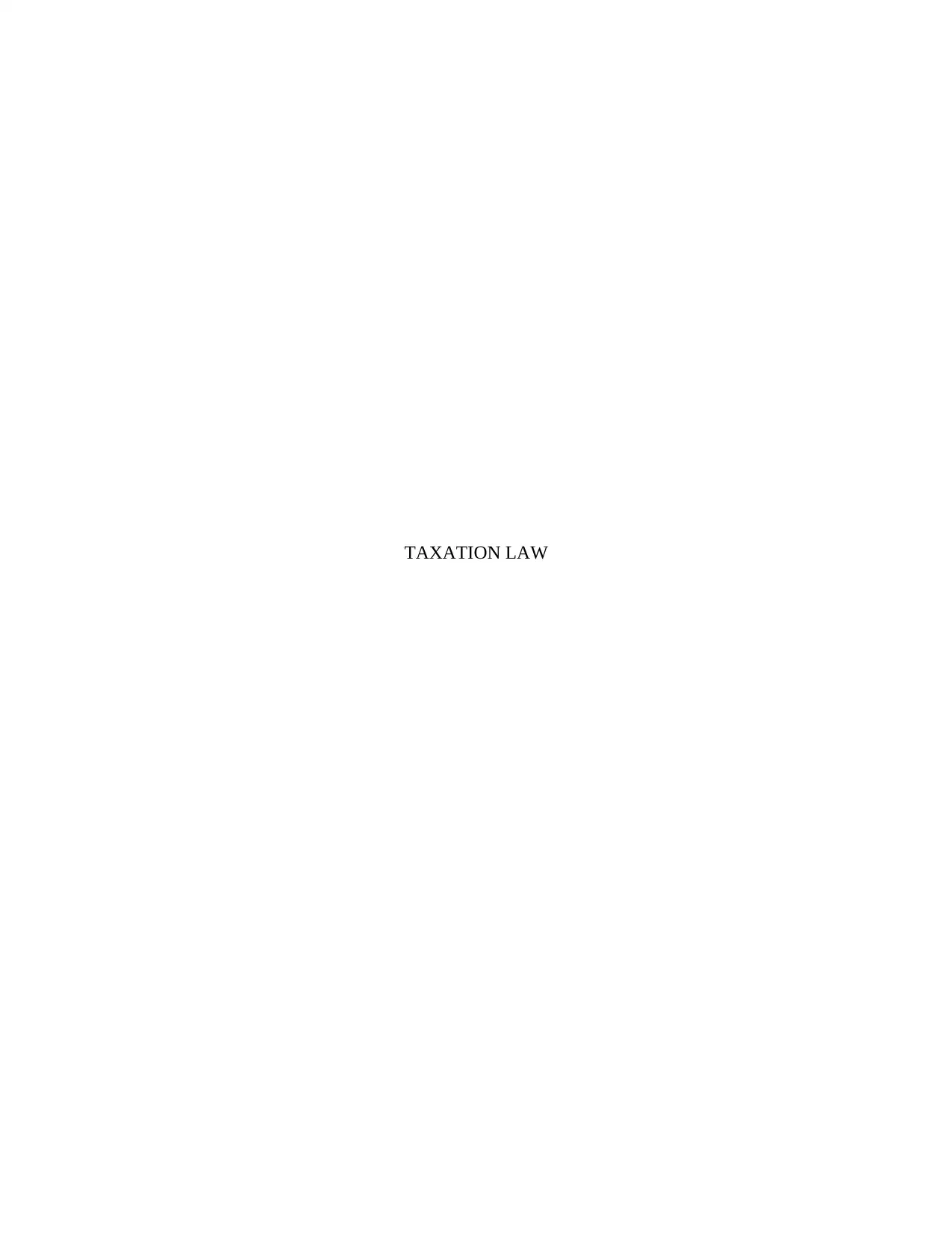
TAXATION LAW
Paraphrase This Document
Need a fresh take? Get an instant paraphrase of this document with our AI Paraphraser
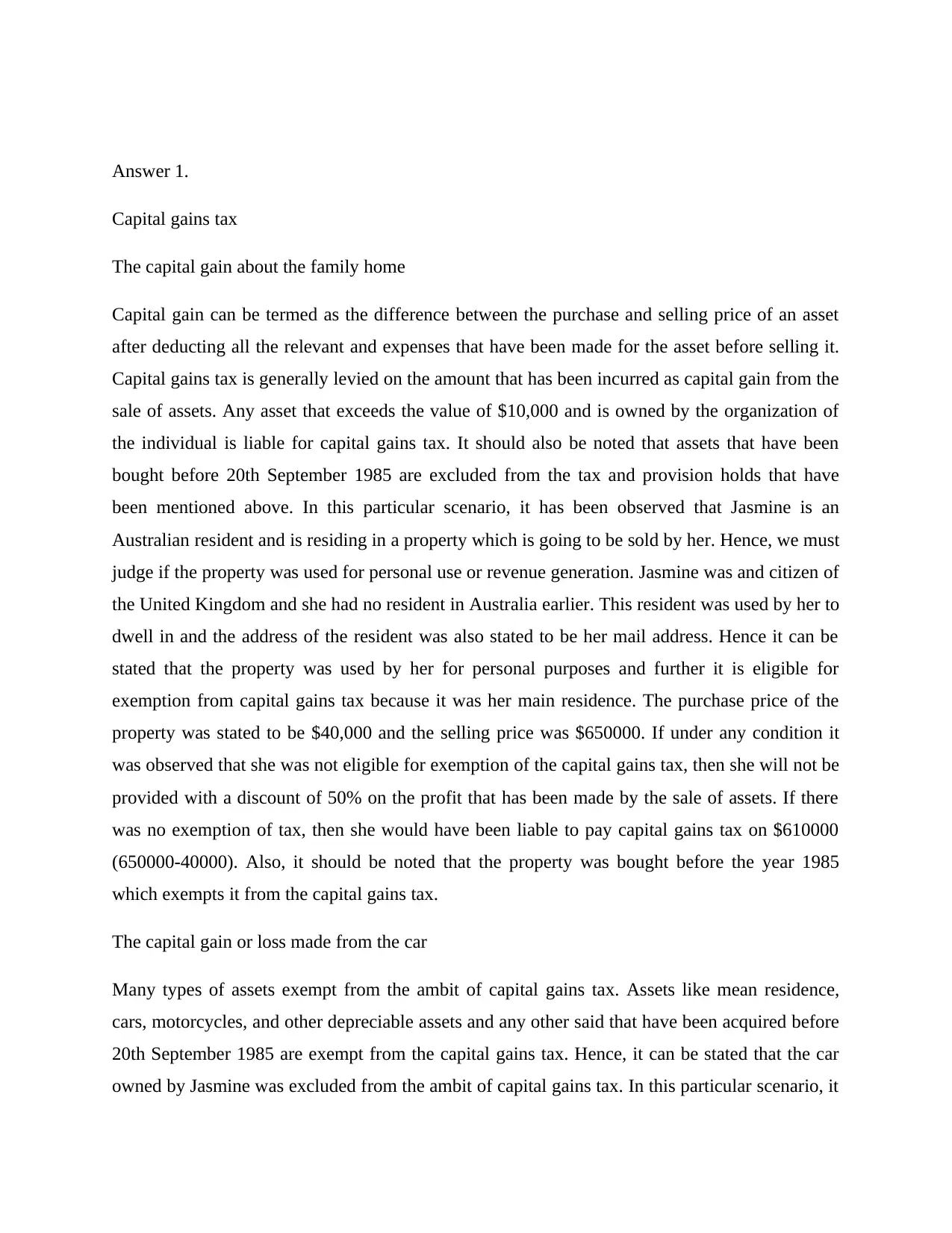
Answer 1.
Capital gains tax
The capital gain about the family home
Capital gain can be termed as the difference between the purchase and selling price of an asset
after deducting all the relevant and expenses that have been made for the asset before selling it.
Capital gains tax is generally levied on the amount that has been incurred as capital gain from the
sale of assets. Any asset that exceeds the value of $10,000 and is owned by the organization of
the individual is liable for capital gains tax. It should also be noted that assets that have been
bought before 20th September 1985 are excluded from the tax and provision holds that have
been mentioned above. In this particular scenario, it has been observed that Jasmine is an
Australian resident and is residing in a property which is going to be sold by her. Hence, we must
judge if the property was used for personal use or revenue generation. Jasmine was and citizen of
the United Kingdom and she had no resident in Australia earlier. This resident was used by her to
dwell in and the address of the resident was also stated to be her mail address. Hence it can be
stated that the property was used by her for personal purposes and further it is eligible for
exemption from capital gains tax because it was her main residence. The purchase price of the
property was stated to be $40,000 and the selling price was $650000. If under any condition it
was observed that she was not eligible for exemption of the capital gains tax, then she will not be
provided with a discount of 50% on the profit that has been made by the sale of assets. If there
was no exemption of tax, then she would have been liable to pay capital gains tax on $610000
(650000-40000). Also, it should be noted that the property was bought before the year 1985
which exempts it from the capital gains tax.
The capital gain or loss made from the car
Many types of assets exempt from the ambit of capital gains tax. Assets like mean residence,
cars, motorcycles, and other depreciable assets and any other said that have been acquired before
20th September 1985 are exempt from the capital gains tax. Hence, it can be stated that the car
owned by Jasmine was excluded from the ambit of capital gains tax. In this particular scenario, it
Capital gains tax
The capital gain about the family home
Capital gain can be termed as the difference between the purchase and selling price of an asset
after deducting all the relevant and expenses that have been made for the asset before selling it.
Capital gains tax is generally levied on the amount that has been incurred as capital gain from the
sale of assets. Any asset that exceeds the value of $10,000 and is owned by the organization of
the individual is liable for capital gains tax. It should also be noted that assets that have been
bought before 20th September 1985 are excluded from the tax and provision holds that have
been mentioned above. In this particular scenario, it has been observed that Jasmine is an
Australian resident and is residing in a property which is going to be sold by her. Hence, we must
judge if the property was used for personal use or revenue generation. Jasmine was and citizen of
the United Kingdom and she had no resident in Australia earlier. This resident was used by her to
dwell in and the address of the resident was also stated to be her mail address. Hence it can be
stated that the property was used by her for personal purposes and further it is eligible for
exemption from capital gains tax because it was her main residence. The purchase price of the
property was stated to be $40,000 and the selling price was $650000. If under any condition it
was observed that she was not eligible for exemption of the capital gains tax, then she will not be
provided with a discount of 50% on the profit that has been made by the sale of assets. If there
was no exemption of tax, then she would have been liable to pay capital gains tax on $610000
(650000-40000). Also, it should be noted that the property was bought before the year 1985
which exempts it from the capital gains tax.
The capital gain or loss made from the car
Many types of assets exempt from the ambit of capital gains tax. Assets like mean residence,
cars, motorcycles, and other depreciable assets and any other said that have been acquired before
20th September 1985 are exempt from the capital gains tax. Hence, it can be stated that the car
owned by Jasmine was excluded from the ambit of capital gains tax. In this particular scenario, it
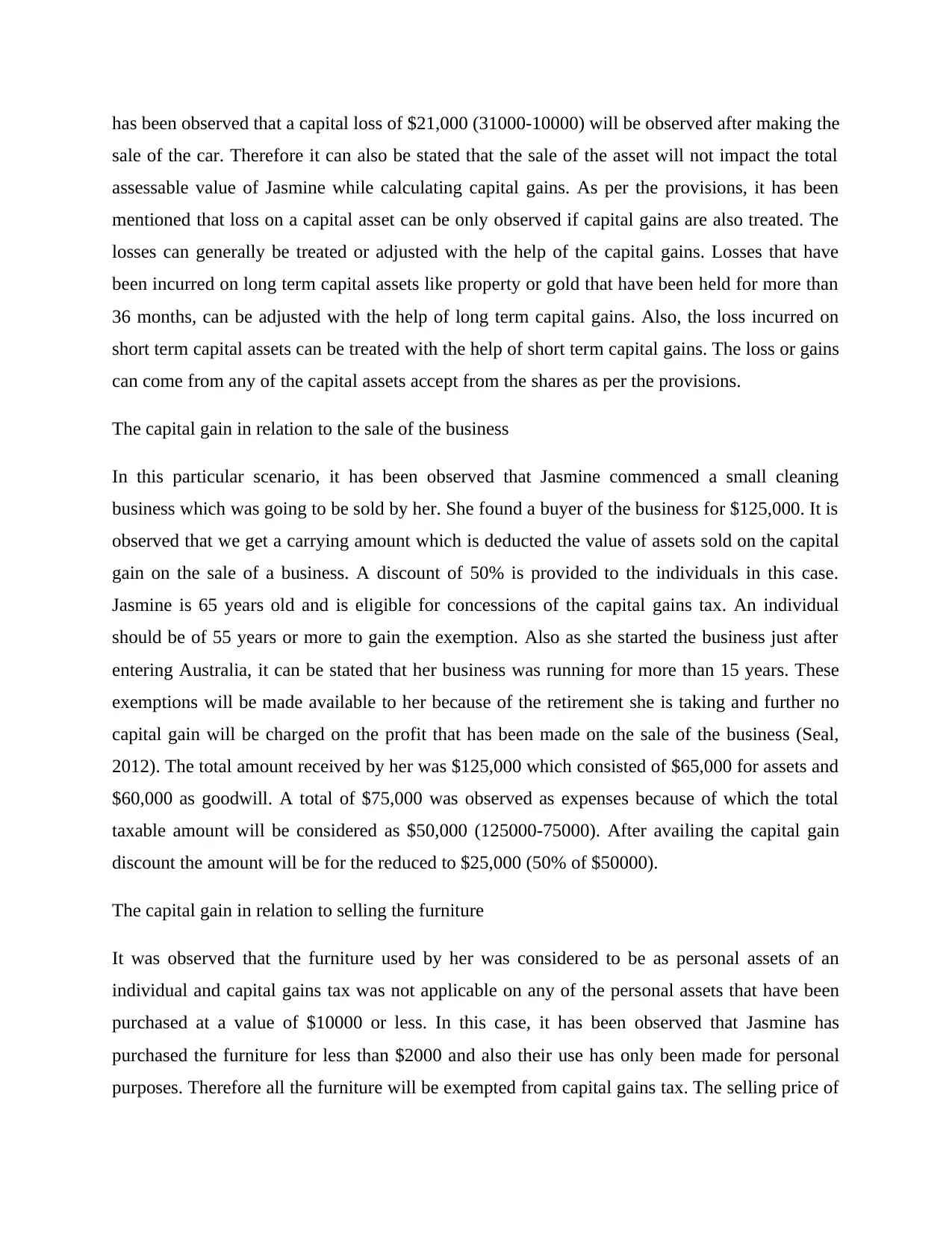
has been observed that a capital loss of $21,000 (31000-10000) will be observed after making the
sale of the car. Therefore it can also be stated that the sale of the asset will not impact the total
assessable value of Jasmine while calculating capital gains. As per the provisions, it has been
mentioned that loss on a capital asset can be only observed if capital gains are also treated. The
losses can generally be treated or adjusted with the help of the capital gains. Losses that have
been incurred on long term capital assets like property or gold that have been held for more than
36 months, can be adjusted with the help of long term capital gains. Also, the loss incurred on
short term capital assets can be treated with the help of short term capital gains. The loss or gains
can come from any of the capital assets accept from the shares as per the provisions.
The capital gain in relation to the sale of the business
In this particular scenario, it has been observed that Jasmine commenced a small cleaning
business which was going to be sold by her. She found a buyer of the business for $125,000. It is
observed that we get a carrying amount which is deducted the value of assets sold on the capital
gain on the sale of a business. A discount of 50% is provided to the individuals in this case.
Jasmine is 65 years old and is eligible for concessions of the capital gains tax. An individual
should be of 55 years or more to gain the exemption. Also as she started the business just after
entering Australia, it can be stated that her business was running for more than 15 years. These
exemptions will be made available to her because of the retirement she is taking and further no
capital gain will be charged on the profit that has been made on the sale of the business (Seal,
2012). The total amount received by her was $125,000 which consisted of $65,000 for assets and
$60,000 as goodwill. A total of $75,000 was observed as expenses because of which the total
taxable amount will be considered as $50,000 (125000-75000). After availing the capital gain
discount the amount will be for the reduced to $25,000 (50% of $50000).
The capital gain in relation to selling the furniture
It was observed that the furniture used by her was considered to be as personal assets of an
individual and capital gains tax was not applicable on any of the personal assets that have been
purchased at a value of $10000 or less. In this case, it has been observed that Jasmine has
purchased the furniture for less than $2000 and also their use has only been made for personal
purposes. Therefore all the furniture will be exempted from capital gains tax. The selling price of
sale of the car. Therefore it can also be stated that the sale of the asset will not impact the total
assessable value of Jasmine while calculating capital gains. As per the provisions, it has been
mentioned that loss on a capital asset can be only observed if capital gains are also treated. The
losses can generally be treated or adjusted with the help of the capital gains. Losses that have
been incurred on long term capital assets like property or gold that have been held for more than
36 months, can be adjusted with the help of long term capital gains. Also, the loss incurred on
short term capital assets can be treated with the help of short term capital gains. The loss or gains
can come from any of the capital assets accept from the shares as per the provisions.
The capital gain in relation to the sale of the business
In this particular scenario, it has been observed that Jasmine commenced a small cleaning
business which was going to be sold by her. She found a buyer of the business for $125,000. It is
observed that we get a carrying amount which is deducted the value of assets sold on the capital
gain on the sale of a business. A discount of 50% is provided to the individuals in this case.
Jasmine is 65 years old and is eligible for concessions of the capital gains tax. An individual
should be of 55 years or more to gain the exemption. Also as she started the business just after
entering Australia, it can be stated that her business was running for more than 15 years. These
exemptions will be made available to her because of the retirement she is taking and further no
capital gain will be charged on the profit that has been made on the sale of the business (Seal,
2012). The total amount received by her was $125,000 which consisted of $65,000 for assets and
$60,000 as goodwill. A total of $75,000 was observed as expenses because of which the total
taxable amount will be considered as $50,000 (125000-75000). After availing the capital gain
discount the amount will be for the reduced to $25,000 (50% of $50000).
The capital gain in relation to selling the furniture
It was observed that the furniture used by her was considered to be as personal assets of an
individual and capital gains tax was not applicable on any of the personal assets that have been
purchased at a value of $10000 or less. In this case, it has been observed that Jasmine has
purchased the furniture for less than $2000 and also their use has only been made for personal
purposes. Therefore all the furniture will be exempted from capital gains tax. The selling price of
⊘ This is a preview!⊘
Do you want full access?
Subscribe today to unlock all pages.

Trusted by 1+ million students worldwide
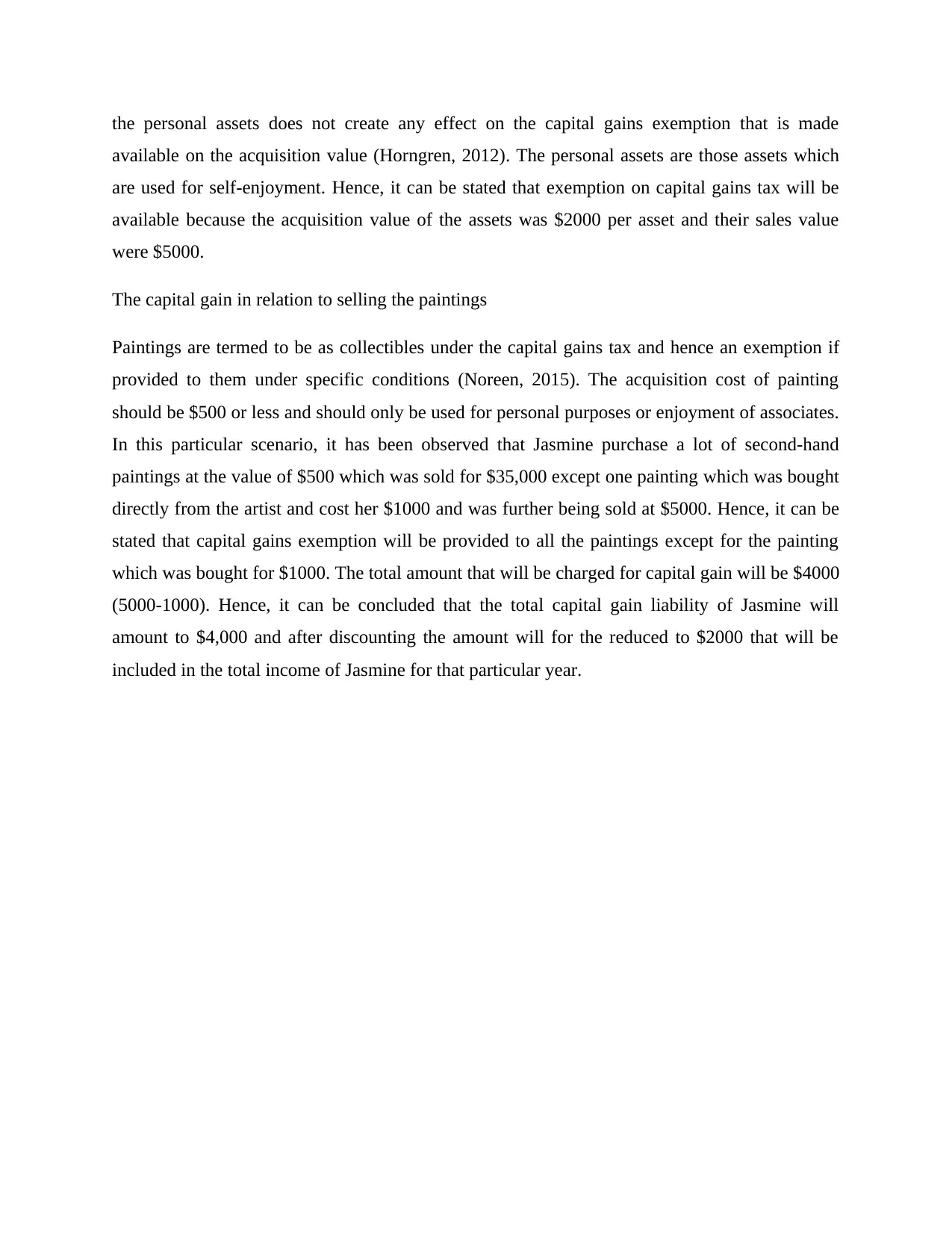
the personal assets does not create any effect on the capital gains exemption that is made
available on the acquisition value (Horngren, 2012). The personal assets are those assets which
are used for self-enjoyment. Hence, it can be stated that exemption on capital gains tax will be
available because the acquisition value of the assets was $2000 per asset and their sales value
were $5000.
The capital gain in relation to selling the paintings
Paintings are termed to be as collectibles under the capital gains tax and hence an exemption if
provided to them under specific conditions (Noreen, 2015). The acquisition cost of painting
should be $500 or less and should only be used for personal purposes or enjoyment of associates.
In this particular scenario, it has been observed that Jasmine purchase a lot of second-hand
paintings at the value of $500 which was sold for $35,000 except one painting which was bought
directly from the artist and cost her $1000 and was further being sold at $5000. Hence, it can be
stated that capital gains exemption will be provided to all the paintings except for the painting
which was bought for $1000. The total amount that will be charged for capital gain will be $4000
(5000-1000). Hence, it can be concluded that the total capital gain liability of Jasmine will
amount to $4,000 and after discounting the amount will for the reduced to $2000 that will be
included in the total income of Jasmine for that particular year.
available on the acquisition value (Horngren, 2012). The personal assets are those assets which
are used for self-enjoyment. Hence, it can be stated that exemption on capital gains tax will be
available because the acquisition value of the assets was $2000 per asset and their sales value
were $5000.
The capital gain in relation to selling the paintings
Paintings are termed to be as collectibles under the capital gains tax and hence an exemption if
provided to them under specific conditions (Noreen, 2015). The acquisition cost of painting
should be $500 or less and should only be used for personal purposes or enjoyment of associates.
In this particular scenario, it has been observed that Jasmine purchase a lot of second-hand
paintings at the value of $500 which was sold for $35,000 except one painting which was bought
directly from the artist and cost her $1000 and was further being sold at $5000. Hence, it can be
stated that capital gains exemption will be provided to all the paintings except for the painting
which was bought for $1000. The total amount that will be charged for capital gain will be $4000
(5000-1000). Hence, it can be concluded that the total capital gain liability of Jasmine will
amount to $4,000 and after discounting the amount will for the reduced to $2000 that will be
included in the total income of Jasmine for that particular year.
Paraphrase This Document
Need a fresh take? Get an instant paraphrase of this document with our AI Paraphraser
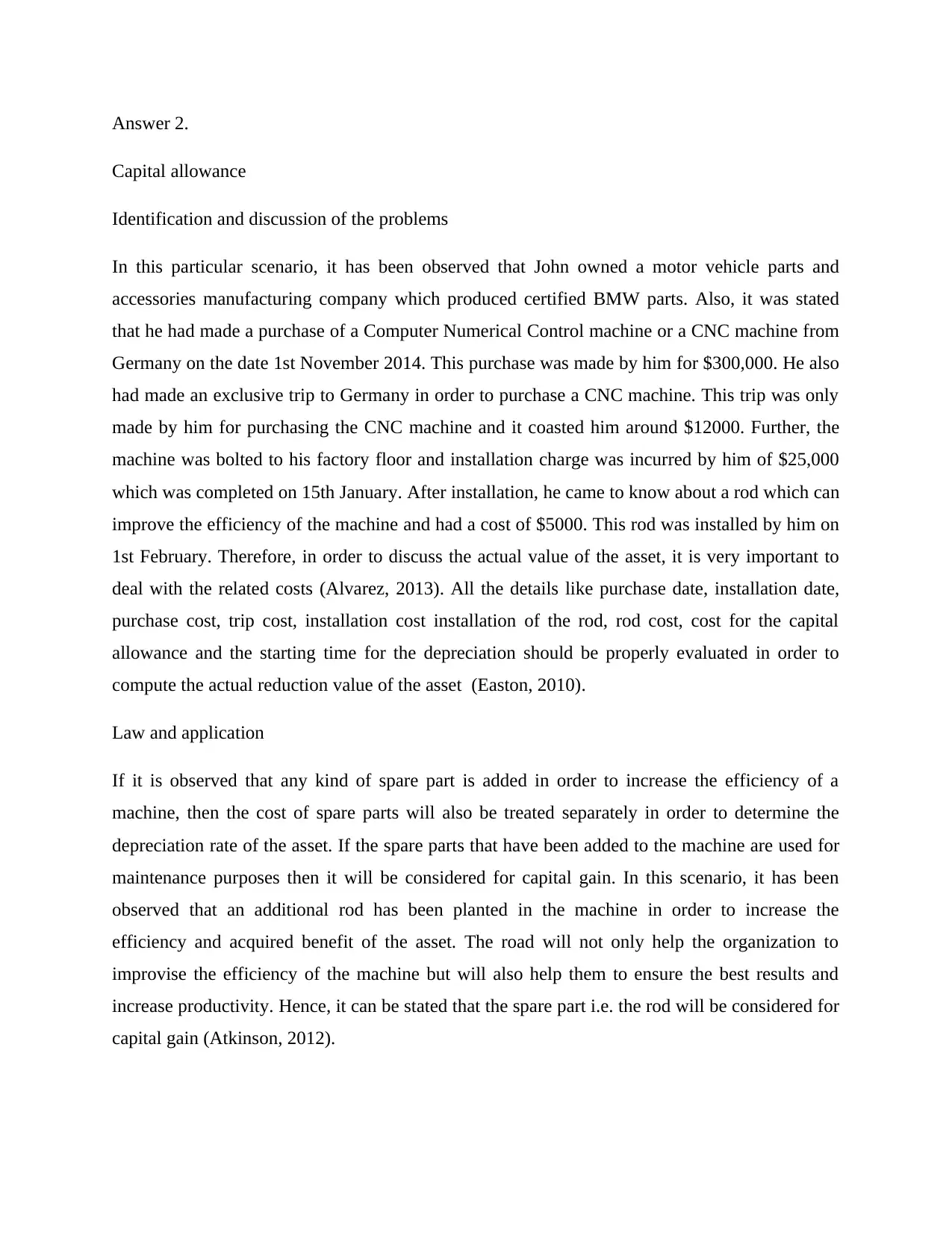
Answer 2.
Capital allowance
Identification and discussion of the problems
In this particular scenario, it has been observed that John owned a motor vehicle parts and
accessories manufacturing company which produced certified BMW parts. Also, it was stated
that he had made a purchase of a Computer Numerical Control machine or a CNC machine from
Germany on the date 1st November 2014. This purchase was made by him for $300,000. He also
had made an exclusive trip to Germany in order to purchase a CNC machine. This trip was only
made by him for purchasing the CNC machine and it coasted him around $12000. Further, the
machine was bolted to his factory floor and installation charge was incurred by him of $25,000
which was completed on 15th January. After installation, he came to know about a rod which can
improve the efficiency of the machine and had a cost of $5000. This rod was installed by him on
1st February. Therefore, in order to discuss the actual value of the asset, it is very important to
deal with the related costs (Alvarez, 2013). All the details like purchase date, installation date,
purchase cost, trip cost, installation cost installation of the rod, rod cost, cost for the capital
allowance and the starting time for the depreciation should be properly evaluated in order to
compute the actual reduction value of the asset (Easton, 2010).
Law and application
If it is observed that any kind of spare part is added in order to increase the efficiency of a
machine, then the cost of spare parts will also be treated separately in order to determine the
depreciation rate of the asset. If the spare parts that have been added to the machine are used for
maintenance purposes then it will be considered for capital gain. In this scenario, it has been
observed that an additional rod has been planted in the machine in order to increase the
efficiency and acquired benefit of the asset. The road will not only help the organization to
improvise the efficiency of the machine but will also help them to ensure the best results and
increase productivity. Hence, it can be stated that the spare part i.e. the rod will be considered for
capital gain (Atkinson, 2012).
Capital allowance
Identification and discussion of the problems
In this particular scenario, it has been observed that John owned a motor vehicle parts and
accessories manufacturing company which produced certified BMW parts. Also, it was stated
that he had made a purchase of a Computer Numerical Control machine or a CNC machine from
Germany on the date 1st November 2014. This purchase was made by him for $300,000. He also
had made an exclusive trip to Germany in order to purchase a CNC machine. This trip was only
made by him for purchasing the CNC machine and it coasted him around $12000. Further, the
machine was bolted to his factory floor and installation charge was incurred by him of $25,000
which was completed on 15th January. After installation, he came to know about a rod which can
improve the efficiency of the machine and had a cost of $5000. This rod was installed by him on
1st February. Therefore, in order to discuss the actual value of the asset, it is very important to
deal with the related costs (Alvarez, 2013). All the details like purchase date, installation date,
purchase cost, trip cost, installation cost installation of the rod, rod cost, cost for the capital
allowance and the starting time for the depreciation should be properly evaluated in order to
compute the actual reduction value of the asset (Easton, 2010).
Law and application
If it is observed that any kind of spare part is added in order to increase the efficiency of a
machine, then the cost of spare parts will also be treated separately in order to determine the
depreciation rate of the asset. If the spare parts that have been added to the machine are used for
maintenance purposes then it will be considered for capital gain. In this scenario, it has been
observed that an additional rod has been planted in the machine in order to increase the
efficiency and acquired benefit of the asset. The road will not only help the organization to
improvise the efficiency of the machine but will also help them to ensure the best results and
increase productivity. Hence, it can be stated that the spare part i.e. the rod will be considered for
capital gain (Atkinson, 2012).
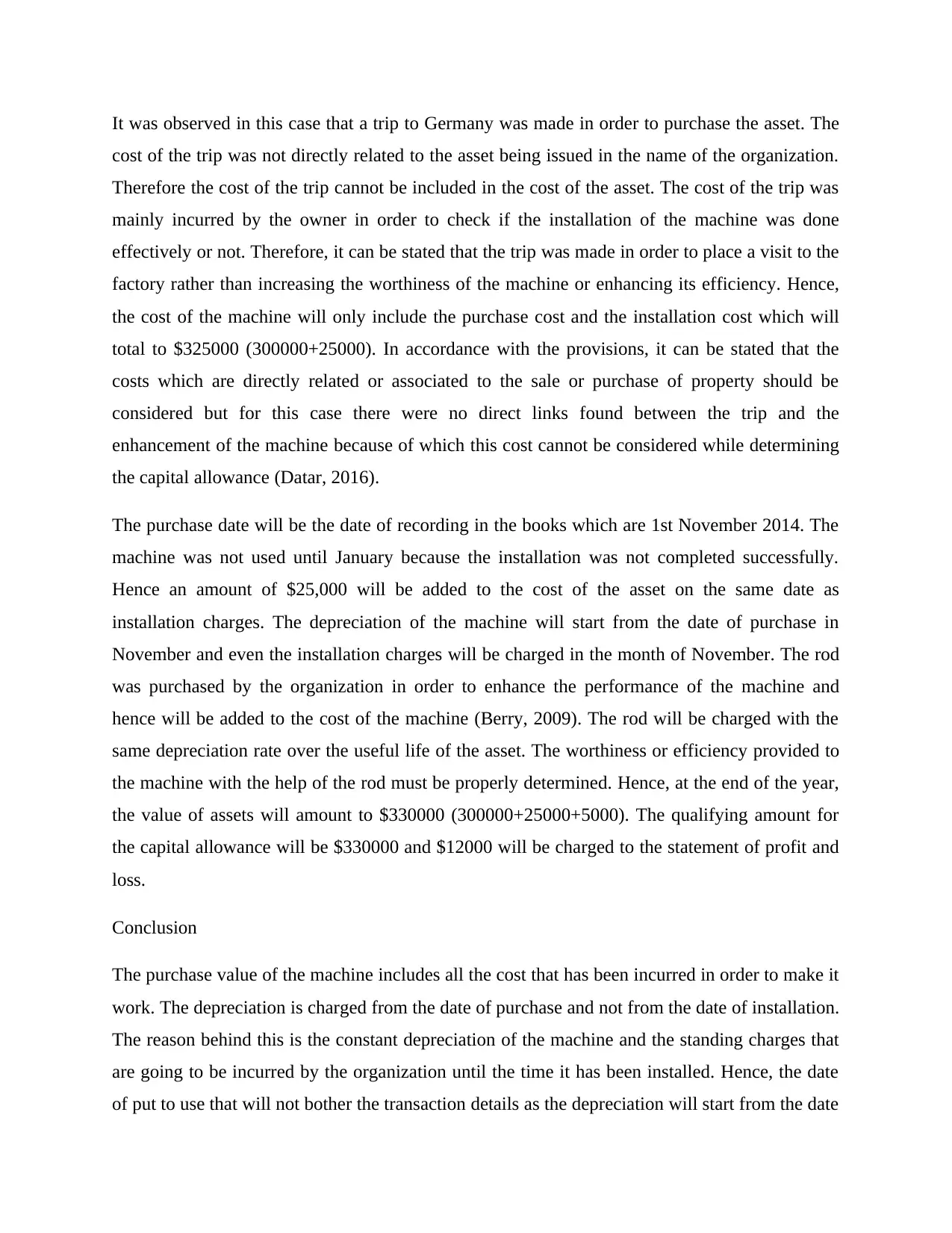
It was observed in this case that a trip to Germany was made in order to purchase the asset. The
cost of the trip was not directly related to the asset being issued in the name of the organization.
Therefore the cost of the trip cannot be included in the cost of the asset. The cost of the trip was
mainly incurred by the owner in order to check if the installation of the machine was done
effectively or not. Therefore, it can be stated that the trip was made in order to place a visit to the
factory rather than increasing the worthiness of the machine or enhancing its efficiency. Hence,
the cost of the machine will only include the purchase cost and the installation cost which will
total to $325000 (300000+25000). In accordance with the provisions, it can be stated that the
costs which are directly related or associated to the sale or purchase of property should be
considered but for this case there were no direct links found between the trip and the
enhancement of the machine because of which this cost cannot be considered while determining
the capital allowance (Datar, 2016).
The purchase date will be the date of recording in the books which are 1st November 2014. The
machine was not used until January because the installation was not completed successfully.
Hence an amount of $25,000 will be added to the cost of the asset on the same date as
installation charges. The depreciation of the machine will start from the date of purchase in
November and even the installation charges will be charged in the month of November. The rod
was purchased by the organization in order to enhance the performance of the machine and
hence will be added to the cost of the machine (Berry, 2009). The rod will be charged with the
same depreciation rate over the useful life of the asset. The worthiness or efficiency provided to
the machine with the help of the rod must be properly determined. Hence, at the end of the year,
the value of assets will amount to $330000 (300000+25000+5000). The qualifying amount for
the capital allowance will be $330000 and $12000 will be charged to the statement of profit and
loss.
Conclusion
The purchase value of the machine includes all the cost that has been incurred in order to make it
work. The depreciation is charged from the date of purchase and not from the date of installation.
The reason behind this is the constant depreciation of the machine and the standing charges that
are going to be incurred by the organization until the time it has been installed. Hence, the date
of put to use that will not bother the transaction details as the depreciation will start from the date
cost of the trip was not directly related to the asset being issued in the name of the organization.
Therefore the cost of the trip cannot be included in the cost of the asset. The cost of the trip was
mainly incurred by the owner in order to check if the installation of the machine was done
effectively or not. Therefore, it can be stated that the trip was made in order to place a visit to the
factory rather than increasing the worthiness of the machine or enhancing its efficiency. Hence,
the cost of the machine will only include the purchase cost and the installation cost which will
total to $325000 (300000+25000). In accordance with the provisions, it can be stated that the
costs which are directly related or associated to the sale or purchase of property should be
considered but for this case there were no direct links found between the trip and the
enhancement of the machine because of which this cost cannot be considered while determining
the capital allowance (Datar, 2016).
The purchase date will be the date of recording in the books which are 1st November 2014. The
machine was not used until January because the installation was not completed successfully.
Hence an amount of $25,000 will be added to the cost of the asset on the same date as
installation charges. The depreciation of the machine will start from the date of purchase in
November and even the installation charges will be charged in the month of November. The rod
was purchased by the organization in order to enhance the performance of the machine and
hence will be added to the cost of the machine (Berry, 2009). The rod will be charged with the
same depreciation rate over the useful life of the asset. The worthiness or efficiency provided to
the machine with the help of the rod must be properly determined. Hence, at the end of the year,
the value of assets will amount to $330000 (300000+25000+5000). The qualifying amount for
the capital allowance will be $330000 and $12000 will be charged to the statement of profit and
loss.
Conclusion
The purchase value of the machine includes all the cost that has been incurred in order to make it
work. The depreciation is charged from the date of purchase and not from the date of installation.
The reason behind this is the constant depreciation of the machine and the standing charges that
are going to be incurred by the organization until the time it has been installed. Hence, the date
of put to use that will not bother the transaction details as the depreciation will start from the date
⊘ This is a preview!⊘
Do you want full access?
Subscribe today to unlock all pages.

Trusted by 1+ million students worldwide

of purchase. Therefore, all these treatments should be properly analyzed otherwise the treatment
of the transaction will become inefficient.
of the transaction will become inefficient.
Paraphrase This Document
Need a fresh take? Get an instant paraphrase of this document with our AI Paraphraser
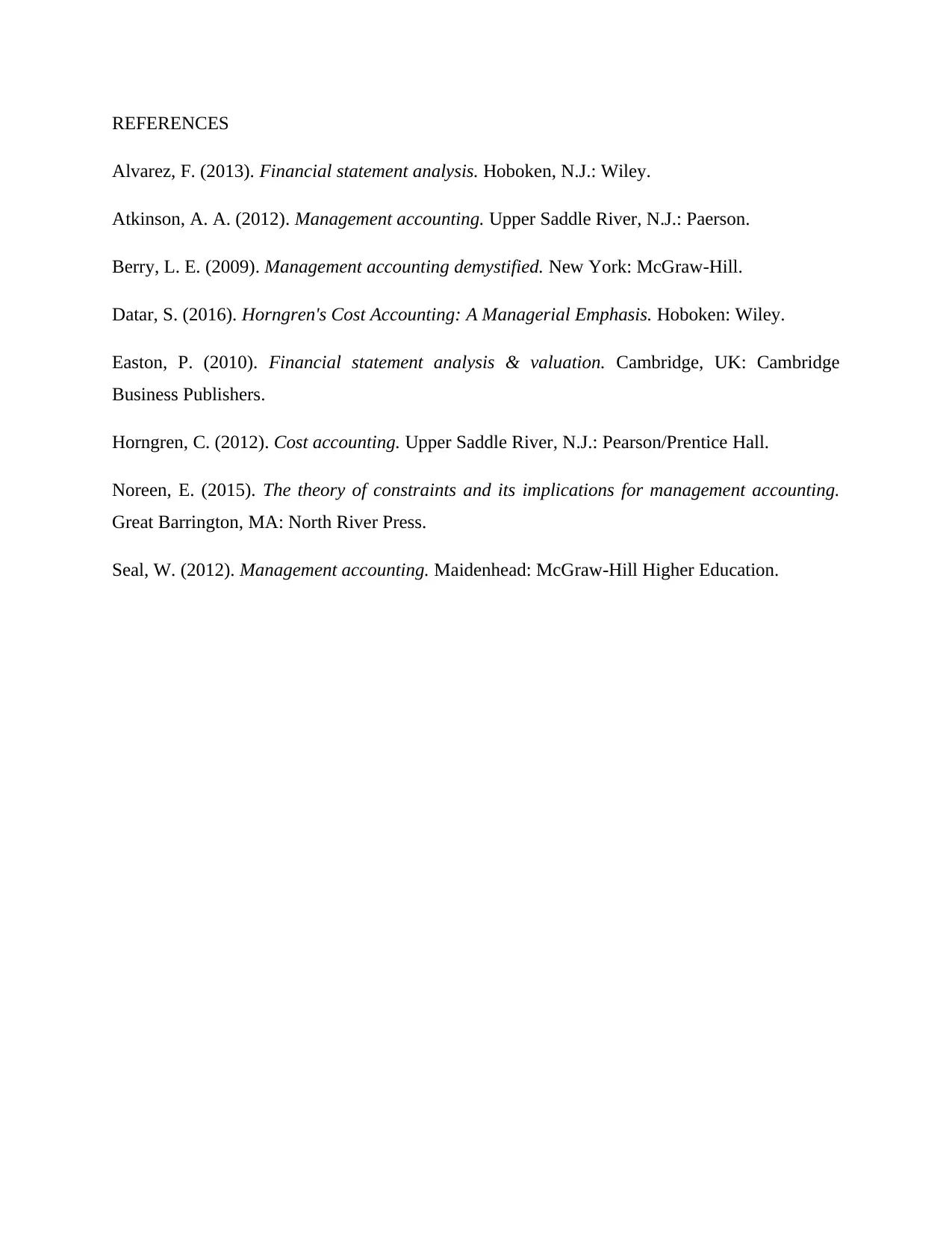
REFERENCES
Alvarez, F. (2013). Financial statement analysis. Hoboken, N.J.: Wiley.
Atkinson, A. A. (2012). Management accounting. Upper Saddle River, N.J.: Paerson.
Berry, L. E. (2009). Management accounting demystified. New York: McGraw-Hill.
Datar, S. (2016). Horngren's Cost Accounting: A Managerial Emphasis. Hoboken: Wiley.
Easton, P. (2010). Financial statement analysis & valuation. Cambridge, UK: Cambridge
Business Publishers.
Horngren, C. (2012). Cost accounting. Upper Saddle River, N.J.: Pearson/Prentice Hall.
Noreen, E. (2015). The theory of constraints and its implications for management accounting.
Great Barrington, MA: North River Press.
Seal, W. (2012). Management accounting. Maidenhead: McGraw-Hill Higher Education.
Alvarez, F. (2013). Financial statement analysis. Hoboken, N.J.: Wiley.
Atkinson, A. A. (2012). Management accounting. Upper Saddle River, N.J.: Paerson.
Berry, L. E. (2009). Management accounting demystified. New York: McGraw-Hill.
Datar, S. (2016). Horngren's Cost Accounting: A Managerial Emphasis. Hoboken: Wiley.
Easton, P. (2010). Financial statement analysis & valuation. Cambridge, UK: Cambridge
Business Publishers.
Horngren, C. (2012). Cost accounting. Upper Saddle River, N.J.: Pearson/Prentice Hall.
Noreen, E. (2015). The theory of constraints and its implications for management accounting.
Great Barrington, MA: North River Press.
Seal, W. (2012). Management accounting. Maidenhead: McGraw-Hill Higher Education.
1 out of 8
Related Documents
Your All-in-One AI-Powered Toolkit for Academic Success.
+13062052269
info@desklib.com
Available 24*7 on WhatsApp / Email
![[object Object]](/_next/static/media/star-bottom.7253800d.svg)
Unlock your academic potential
Copyright © 2020–2025 A2Z Services. All Rights Reserved. Developed and managed by ZUCOL.




